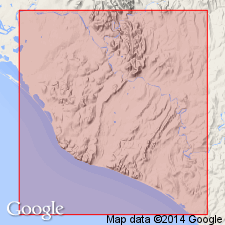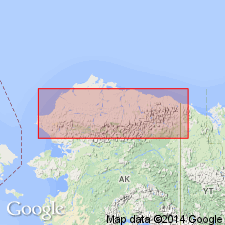
- Usage in publication:
-
- Cape Thompson Member*
- Modifications:
-
- Named
- Dominant lithology:
-
- Limestone
- AAPG geologic province:
-
- Alaska Northern region
Summary:
Type locality forms promontory of Cape Thompson for which unit is named. Shown on geologic map of area in vicinity of Chariot Site, Lisburne Peninsula, northwestern AK. Is middle member (of 3) of Nasorak Formation. Upper and lower members are unnamed. Consists of about 225 ft of massively outcropping very thick-bedded light-gray to light-olive-gray limestone which is chiefly a crinoid biosparite, composed almost exclusively of coarse sand- to fine-pebble-sized crinoid stem fragments and columnals. Locally contains minor amount of very fine quartz silt that has been partly dolomitized and partly silicified. Overlies unnamed shale member. Underlies about 50 ft of very thick-bedded grayish-black calcareous mudstone containing pyrite concretions and few pyritized fossils. Based on included fossils age is considered Early Mississippian.
Source: GNU records (USGS DDS-6; Menlo GNULEX).

- Usage in publication:
-
- Cape Thompson Member*
- Modifications:
-
- Age modified
- AAPG geologic province:
-
- Alaska Northern region
Summary:
Age of Nasorak Formation [and thus Cape Thompson Member] is Late Mississippian based on revised megafossil zonations. Assemblages (corals, goniatites, mollusks, brachiopods, plants) in Lisburne Peninsula range from Meramecian to Chesterian in age.
Source: GNU records (USGS DDS-6; Menlo GNULEX).
For more information, please contact Nancy Stamm, Geologic Names Committee Secretary.
Asterisk (*) indicates published by U.S. Geological Survey authors.
"No current usage" (†) implies that a name has been abandoned or has fallen into disuse. Former usage and, if known, replacement name given in parentheses ( ).
Slash (/) indicates name conflicts with nomenclatural guidelines (CSN, 1933; ACSN, 1961, 1970; NACSN, 1983, 2005, 2021). May be explained within brackets ([ ]).

